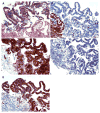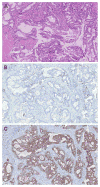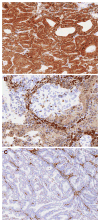Application of Immunohistochemistry and Molecular Diagnostics to Clinically Relevant Problems in Endometrial Cancer Bojana Djordjevic, Shannon Westin, Russell R. Broaddus
- PMID: 23687522
- PMCID: PMC3653323
- DOI: 10.1016/j.path.2012.08.004
Application of Immunohistochemistry and Molecular Diagnostics to Clinically Relevant Problems in Endometrial Cancer Bojana Djordjevic, Shannon Westin, Russell R. Broaddus
Abstract
A number of different clinical scenarios are presented in which lab-based analyses beyond the usual diagnosis based on light microscopic examination of H&E stained slides - immunohistochemistry and PCR-based assays such as sequencing, mutation testing, microsatellite instability analysis, and determination of MLH1 methylation - are most helpful for guiding diagnosis and treatment of endometrial cancer. The central goal of this information is to provide a practical guide of key current and emerging issues in diagnostic endometrial cancer pathology that require the use of ancillary laboratory techniques, such as immunohistochemistry and molecular testing. The authors present the common diagnostic problems in endometrial carcinoma pathology, types of endometrial carcinoma, description of tissue testing and markers, pathological features, and targeted therapy.
Keywords: Lynch Syndrome; endometrial cancer; targeted therapy.
Figures









Similar articles
-
Testing strategies for Lynch syndrome in people with endometrial cancer: systematic reviews and economic evaluation.Health Technol Assess. 2021 Jun;25(42):1-216. doi: 10.3310/hta25420. Health Technol Assess. 2021. PMID: 34169821 Free PMC article.
-
Universal endometrial cancer tumor typing: How much has immunohistochemistry, microsatellite instability, and MLH1 methylation improved the diagnosis of Lynch syndrome across the population?Cancer. 2019 Sep 15;125(18):3172-3183. doi: 10.1002/cncr.32203. Epub 2019 May 31. Cancer. 2019. PMID: 31150123 Review.
-
Utility of MLH1 methylation analysis in the clinical evaluation of Lynch Syndrome in women with endometrial cancer.Curr Pharm Des. 2014;20(11):1655-63. doi: 10.2174/13816128113199990538. Curr Pharm Des. 2014. PMID: 23888949 Free PMC article.
-
Importance of PCR-based Tumor Testing in the Evaluation of Lynch Syndrome-associated Endometrial Cancer.Adv Anat Pathol. 2017 Nov;24(6):372-378. doi: 10.1097/PAP.0000000000000169. Adv Anat Pathol. 2017. PMID: 28820751 Free PMC article. Review.
-
Lynch syndrome-associated endometrial carcinoma with MLH1 germline mutation and MLH1 promoter hypermethylation: a case report and literature review.BMC Cancer. 2018 May 21;18(1):576. doi: 10.1186/s12885-018-4489-0. BMC Cancer. 2018. PMID: 29783979 Free PMC article. Review.
Cited by
-
Utility of ER, p53, CEA and Napsin A in Histological Subtyping of Endometrial Carcinoma and Their Correlation with Clinicopathological Prognostic Parameters: Experience from a Referral Institute.Iran J Pathol. 2024 Spring;19(2):236-243. doi: 10.30699/IJP.2024.2008693.3154. Epub 2024 Jan 29. Iran J Pathol. 2024. PMID: 39118789 Free PMC article.
-
The Correlation of the IETA Ultrasound Score with the Histopathology Results for Women with Abnormal Bleeding in Western Romania.Diagnostics (Basel). 2021 Jul 26;11(8):1342. doi: 10.3390/diagnostics11081342. Diagnostics (Basel). 2021. PMID: 34441275 Free PMC article.
-
Utilization of immunohistochemistry in gynecologic tumors: An expert review.Gynecol Oncol Rep. 2024 Nov 29;56:101550. doi: 10.1016/j.gore.2024.101550. eCollection 2024 Dec. Gynecol Oncol Rep. 2024. PMID: 39717157 Free PMC article. Review.
-
Review of immunohistochemical typing of endometrial carcinoma at the Lagos University Teaching Hospital.Afr Health Sci. 2019 Sep;19(3):2468-2475. doi: 10.4314/ahs.v19i3.22. Afr Health Sci. 2019. PMID: 32127819 Free PMC article.
-
Endometrioid adenocarcinoma of the colon arising from rare malignant transformation of extra-gonadal endometrioma.Gynecol Oncol Rep. 2024 Dec 17;57:101664. doi: 10.1016/j.gore.2024.101664. eCollection 2025 Feb. Gynecol Oncol Rep. 2024. PMID: 39840072 Free PMC article.
References
-
- McCluggage WG, Sumathi VP, McBride HA, Patterson A. A panel of immunohistochemical stains, including carcinoembryonic antigen, vimentin, and estrogen receptor, aids the distinction between primary endometrial and endocervical adenocarcinomas. Int J Gynecol Pathol. 2002 Jan;21(1):11–5. - PubMed
-
- Dabbs DJ, Sturtz K, Zaino RJ. The immunohistochemical discrimination of endometrioid adenocarcinomas. Hum Pathol. 1996 Feb;27(2):172–7. - PubMed
-
- Castrillon DH, Lee KR, Nucci MR. Distinction between endometrial and endocervical adenocarcinoma: an immunohistochemical study. Int J Gynecol Pathol. 2002 Jan;21(1):4–10. - PubMed
-
- Staebler A, Sherman ME, Zaino RJ, Ronnett BM. Hormone receptor immunohistochemistry and human papillomavirus in situ hybridization are useful for distinguishing endocervical and endometrial adenocarcinomas. Am J Surg Pathol. 2002 Aug;26(8):998–1006. - PubMed
-
- Han CP, Lee MY, Kok LF, et al. Adding the p16(INK4a) marker to the traditional 3-marker (ER/Vim/CEA) panel engenders no supplemental benefit in distinguishing between primary endocervical and endometrial adenocarcinomas in a tissue microarray study. Int J Gynecol Pathol. 2009 Sep;28(5):489–96. - PubMed
Grants and funding
LinkOut - more resources
Full Text Sources
Miscellaneous

